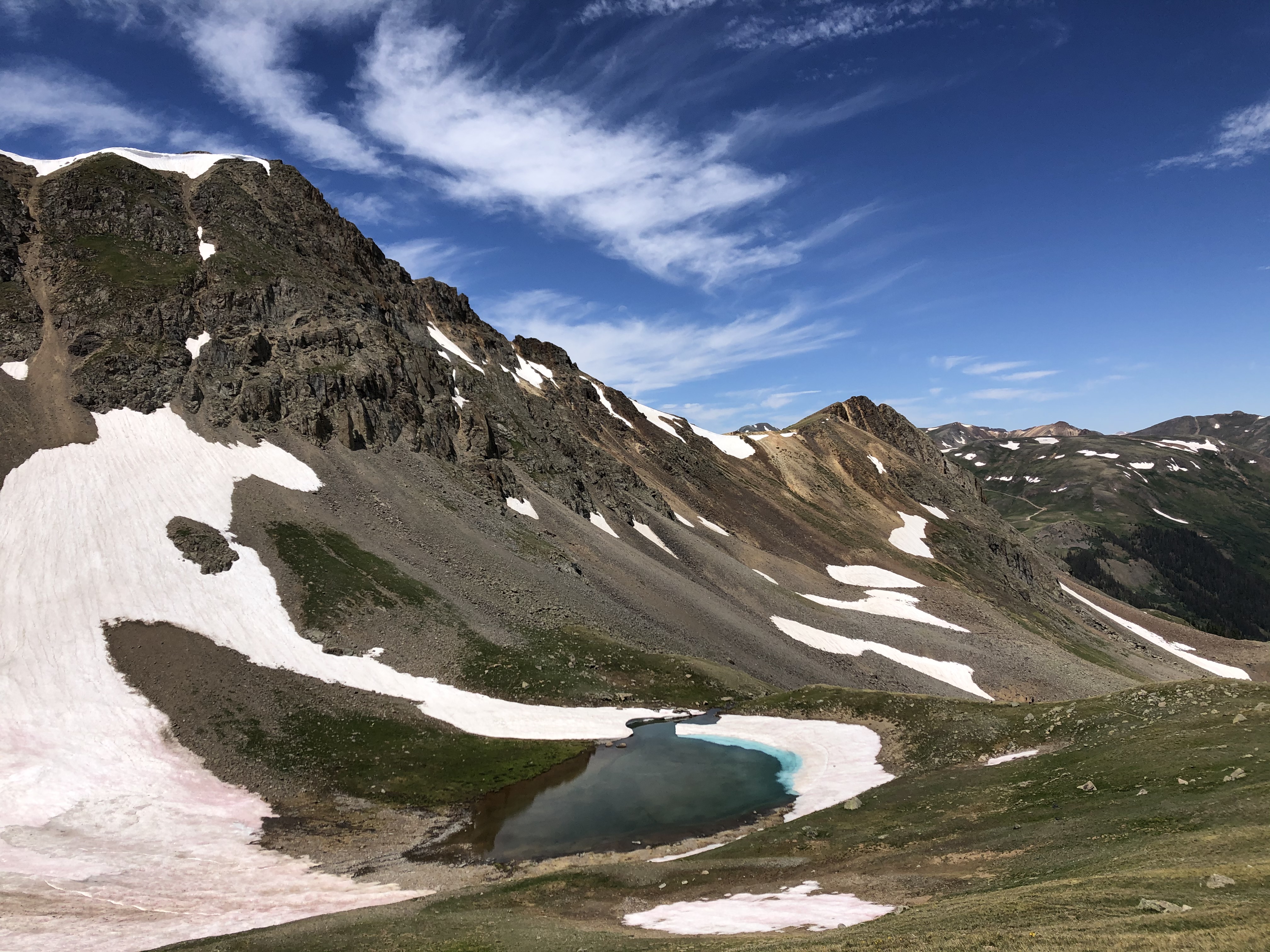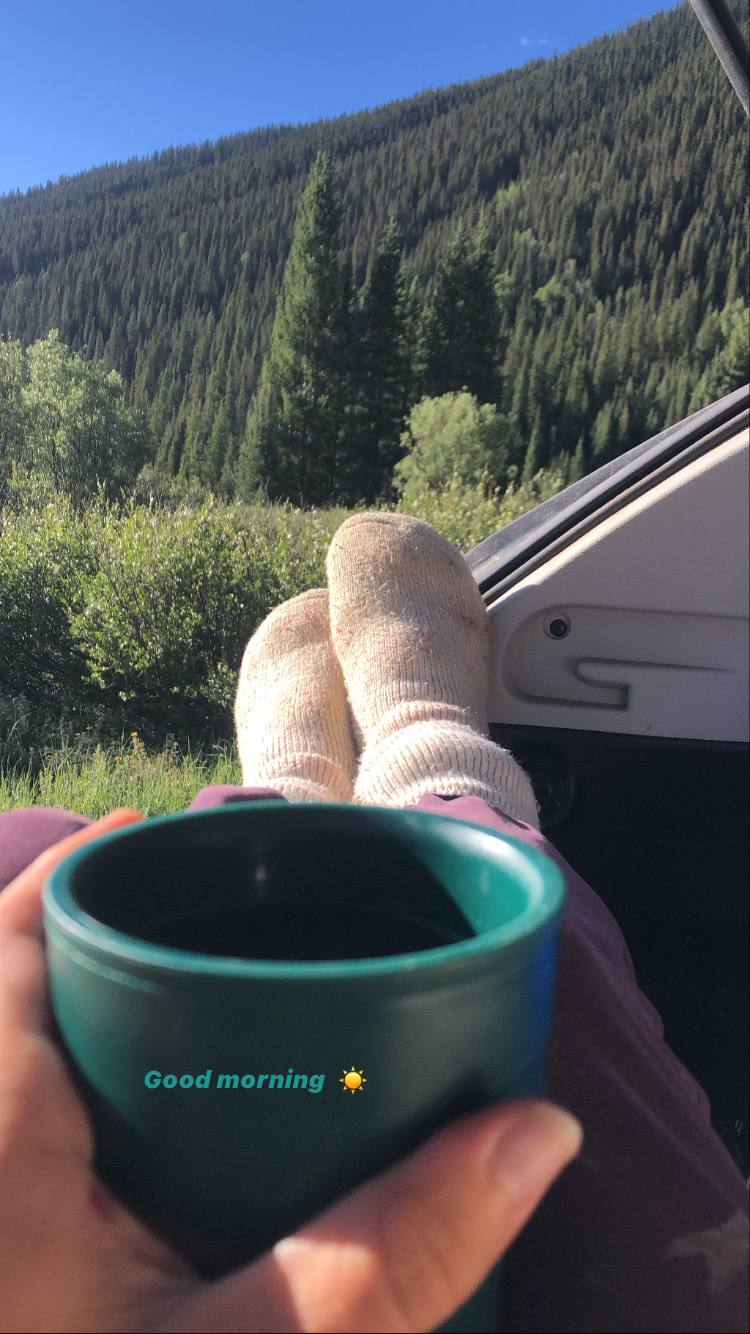You can live out of a red carry-on sized suitcase for two months. I know this because I just did it and that tattered red suitcase became a makeshift table, computer stand for watching Netflix and even a laundry folding station. At the end of June I took a trip to southern Colorado with two of my closest friends to celebrate my birthday early and escape the desert valley heat. After the quick weekend getaway, I couldn’t get it out of my head to take off and work remotely while delving deeper into my own happiness the best way I know how: trail running in the mountains.
Many work situations have shifted and, as someone who works in digital media full-time, I was able to work remotely. I came back home after that weekend and thought of all the things I would need to go back to Colorado for a week or two. I got a new cooler, a portable charging block for my computer and gadgets, a camp chair and more endurance gels and snacks that I could imagine needing (I needed them all!)

I drove up the 8 hours in my Subaru Crosstrek, listening to multiple podcasts on the way and made the back of my car comfy. Standing at 5’3, the back of my Crosstrek is the ideal camping situation that I can make extra cozy. I layered two sleeping pads, several blankets, my sleeping bag and a comforter. I brought a down jacket, a windbreaker, a rain jacket, multiple pairs of shorts and leggings, socks, a sweatshirt, long sleeved tops and tanks, a pair of jeans and casual tops to go out in public looking nicely and even a swimsuit (hello hot springs and cold plunges!)

I had to bring my laptop, set up a hotspot, an iPad and brought along several books and my journal. Camping in my car made finding spots to sleep easier than setting up my tent (which I also brought along). The small grocery store made it easy for me to restock on essentials: soy yogurt, protein bars, fruit, sparkling water (my addiction), rice and pasta, bread, almond butter and jelly, salad and plenty of beans and lentils. I brought my one burner cook stove as well as my jetboil to quickly make hot water for coffee and oats. My eating was simple and routine, but it worked so well for me.
If I woke up early with the sun I would head out in the cool temps, sometimes in the 40s to start, and begin to climb up a trail or dirt road that would promise alpine lakes or waterfalls or beautiful mountain views. If I slept in a little longer, to the background symphony of ATV’s and jeep off roaders, I would head straight to the Coffee Bear to start my work day after brushing my hair and teeth and changing into clothes that I could go for a run in after I was done with my work day. Coffee in hand, I’d pass my work day and then seek out my next adventure.
I took all of my camping gear as well: my light one person tent took up almost no room and for a week I set it up on a dispersed site while my friends were in town to celebrate my birthday with me! It was nice to switch up how I was sleeping and gave me versatility no matter where in the San Juan corridor I was.

The San Juan mountains took my breath away two years ago for the first time but I’d never been able to spend longer than 3 or 4 days there to explore. With nothing but time, I’d pick any gulch or dirt road to explore, with every route gaining over 2k of elevation, easily. I got very good at power hiking and running downhills. With every hour spent out taking in the views of alpine flowers and sometimes being hailed and rained on, I found gratitude and joy that I hadn’t felt in the heat of Arizona lately.

Living out of my car in a small mining town slowed everything down. It stripped away the hustle and bustle and I relished in the simplicity of work, running and eating (and repeating). I stopped stressing, my anxiety dropped and my mood increased. When I woke up and went to bed every day, I got to look out at beautiful, rugged mountains and spend hours adventure running with no other agenda than to be out in nature. I cooked simply, read more books, wrote more in my journal, snuck showers and released putting pressure on myself to hit certain miles or speeds. I solely focused on enjoying the moment. I wound up averaging 55+ mile weeks with over 14,000 feet of gain for weeks on end, just from being excited and having a desire to get outside. I was trail running and climbing mountain after mountain and had no end goal in sight. I wasn’t training for a race or trying to optimize my running in any certain way, I was simply recreating and moving for the fun of it. It had been quite a long time since I’d gone out just for the thrill of it without a training plan attached.

I also learned that altitude training adjustment takes time and varies person to person. For me: it takes a lot out of me to do. I never fully felt like I was recovered even when I knew I was eating a lot, getting adequate sleep and using recovery tools (hello theraguns and snowmelt creek plunges). I wasn’t able to trail run consistently without feeling like I was overexerting, so I took the uphill efforts as a gift to get stronger in a different way with lots of power hiking. I will say, I felt better the entire time comparatively to how I feel when I am running in 100+ degree temps. My Coros watch told me almost every day that I was in “Recovery Mode” with my effort where my efforts are always much higher in Arizona summer weather. Clearly I respond more positively to cooler temps, thinner air and longer endurance climbs.

Some research suggests that altitude training and heat training are interchangeable and each of them benefits the other. This Outside Magazine article states, “One of the key determinants of endurance performance is how quickly you can ferry oxygen from your lungs to your muscles via your blood. Specifically, it’s the hemoglobin in your red blood cells that grabs the oxygen. Spend a few weeks at high altitude, where the air is thin, and your body responds by generating more hemoglobin. That’s why the vast majority of elite endurance athletes do altitude training.” I am not fully sure I felt stronger when I came back down to Arizona and began trail running in 107 degree heat again, but I will say that I felt stronger in altitude conditions than I ever had before.
This Fleet Feet article shares, “Training in the heat does work slightly differently than altitude training, although the main outcome: increased oxygen delivery to the muscles remains the same. Training at higher elevations creates additional red blood cells, while training in the heat increases your blood plasma volume, which enhances circulation, oxygen delivery, and results in a higher VO2 max at a given effort level. Training in the heat will also increase your sweat rate, decrease your heart rate, and improve your running economy. The increases in strength and endurance resulting from your heat training should last for months if your training remains consistent. This is one big reason why people who have trained consistently in the summer heat often feel great when they start running fall races.”
When I was up in Colorado I was reminded how little I truly need to be happy, train consistently and to feel strong and good in my own skin. I want to bring that mentality into every day life…
When I came back to Arizona nearly three weeks ago I felt the impact of heat again as my heart rate rose rapidly and my breathing heaved on every run. My weekly mileage dropped back down around 30 miles but I began to increase my cross-training, getting out on my bike frequently each week. Then, over the past weekend, I celebrated my friend Annie’s birthday with her by running a #Pool2PoolUltra, running from her pool to mine until we didn’t want to continue on. After lower mileage training being able to go straight into running 28 miles felt like a stamp of success that recent training up high and in the heat has been paying off, even if it is harder to see in the moment.

When I was up in Colorado I was reminded how little I truly need to be happy, train consistently and to feel strong and good in my own skin. I want to bring that mentality in to every day life, even when I’m not in quarantine and lean in to my new found love of dirtbagging it on a whim. If you have a career that allows you to work remotely and travel, I highly recommend giving yourself the opportunity to try it and see how you feel.

About the Author
Bri is an avid trail and ultrarunner based in the desert of Arizona. She has founded an all women’s trail running community called Wild Women Running and shares her race recaps, adventures, and favorite things via her running blog, briwithaview.

What an incredible adventure, although sleeping in your car alone with no one around seems a bit risky!
LikeLiked by 2 people
Thank you so much for sharing!
LikeLiked by 1 person
of course, thank you so much for the story!
LikeLike
Great post, sounds amazing!
LikeLiked by 1 person
Really amazing and worth reading… like the brave attitude of yours.
LikeLiked by 1 person
Very cool! the san juans are an incredible place to be
LikeLiked by 1 person
Heck yeah!
LikeLike
This sounds and looks amazing. I’m hoping to go tobthe Atlas mountains at some point this year for altitude training. Hopefully covid doesn’t scupper it. 🏃♂️
LikeLiked by 1 person